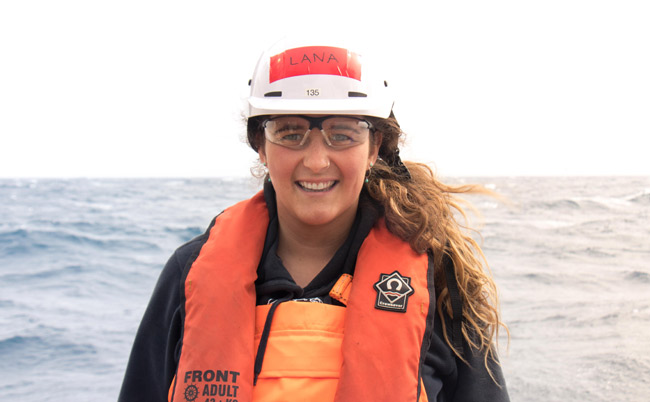Wednesday 14 November 2018 12:34pm

Science Communication student Lana Young aboard NIWA’s research vessel on the Chatham Rise east of the South Island. Photo: Sadie Mills, NIWA.
Currently on the high seas east of New Zealand for research, Master of Science Communication student Lana Young is one of eight Otago students selected as a 2018 Sir Peter Blake Trust Ambassador.
Now three weeks into a 29 day expedition aboard NIWA’s science research vessel Tangaroa, Lana is assisting scientists research salp and helping communicate the wonderful world of these “little vacuum cleaners of the ocean” that play a big role in the ocean’s health.
In addition to being a marine food source, salp also contribute to the ocean’s carbon cycle by transferring significant amounts of carbon from the surface to deep waters through defecating and upon death.
"Studying and practising science communication has given me some confidence on how to approach the communication aims of the expedition."
But while their importance for carbon flows and ocean productivity is recognised, the expedition is gaining further knowledge on the relationship between salp and other planktonic communities.
“We've found some salp almost 30cm long, which is baffling to me!” says Lana. “They use jet propulsion to move around, so some of the individuals can really move quite fast.”
The voyage is concentrating on the Chatham Rise east of the South Island where converging subtropical and subantarctic water masses create a productive nutrient-rich environment that salp thrive in.
With a Bachelor of Science in Zoology and a Postgraduate Diploma in Marine Science, Lana realised her passion was for communicating her work which led to pursuing a Master of Science Communication specialising in documentary filmmaking.
“Photography and video feels like a growing area of importance and scientists often don’t have time to do those things when they're in the midst of their experiments, so it’s cool to be able to fill that gap,” she says.
"We're completely surrounded by sea and there's no signs of human life anywhere near us, yet every time we pull up our plankton nets, they are so full of life. It's a nice reminder of how much else is out there."
“Studying and practising science communication has given me some confidence on how to approach the communication aims of the expedition.”
Lana and another ambassador on the voyage, Siobhan O'Connor from Victoria University, are broadcasting regular vlogs while at sea to show some of the 'behind the scenes' science.
Both ambassadors are working 12 hour shifts and in her spare time Lana is filming white chinned petrels as the subject of her 25 minute film required for her Master's, but says the calm weather to date is both a “blessing and curse”.
“It means that the birds aren't up to their usual aerial acrobatics and look a little more like ducks on a pond, but it does make filming them a lot easier.”
While the calm conditions haven’t been ideal for filming active birds, Lana says it’s made getting accustomed to life at sea a lot more pleasant and she is relishing the experience before the voyage ends in Wellington on 22 November.
“We're completely surrounded by sea and there's no signs of human life anywhere near us, yet every time we pull up our plankton nets, they are so full of life. It's a nice reminder of how much else is out there.”
Otago’s other 2018 Sir Peter Blake Trust Ambassadors are Millie Mannering, Skye Anderson, Aidan Braid, Adam Currie, Sarah Manktelow, Erin Greenwood and Emily Gordon.
